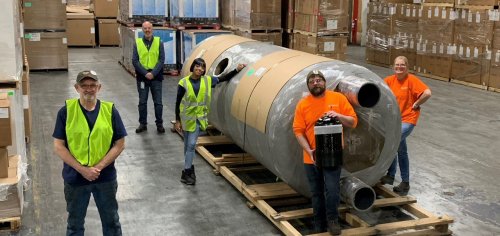If you’ve worked for a sales-driven distributor for any reasonable length of time (like, say, one day), you have heard certain phrases from the mouths of your account managers. Among the most popular are:
“Nothing happens until somebody sells something.”
“My customers are different.”
“There’s more price competition here than in other parts of the country.”
“You can’t sell out of an empty wagon.”
The last saying is a plea to bring in more inventory. As a once-upon-a-time branch manager, I heard this regularly and – being sales-oriented myself – I usually obliged, often to the dismay of my boss, who kept talking about something called “working capital.” I didn’t know what that meant but I suspected it was some version of Washington, D.C. where our representatives actually got things done. In other words, not real and not relevant to me. So, I kept bringing in stock, which showed up in our warehouse and also in my performance review.
Years later, after much experience and a business school education that unveiled the existence of the balance sheet and the penalties of the carrying cost of inventory, I mended my ways and began to care about working capital. Much to the consternation of sales reps who used to love me.
Since the dawn of distribution, we have worked to bring in the exact SKUs in the perfect quantities so we can simultaneously optimize availability and turnover. The problem is: it’s impossible. When I was at Grainger (a company known for its terrific inventory management chops) we used to say, “There are two different kinds of inventory forecasts: wrong ones and lucky ones.” Inventory is sold to people, who are unpredictable at best.
And I don’t think artificial intelligence is going to solve this problem. I personally believe that someday, somewhere, the global network of AI systems and devices will throw up its virtual hands, yell, “I CAN’T WORK WITH THESE PEOPLE!” – referring to all of us – and then zap itself into the next SpaceX rocket headed to Mars. Artificial intelligence can’t compete with authentic craziness.
Selling Out of Other People’s Wagons
But – it turns out there is a solution: marketplaces. Famously popularized by Amazon, a marketplace is an aggregation of everyone’s wagons. Amazon doesn’t stock 500 million SKUs, but that’s how many it offers to its customers. That’s because (by some estimates), Amazon and Amazon Business (two different marketplaces), offer up the combined assortment of an estimated two million sellers – retailers, distributors and manufacturers that put some or all of their products on the company’s websites.
Consider this: in Grainger’s 2017 “Fact Book,” the company claimed to carry a total assortment of 1.7 million SKUs. That means Amazon has more suppliers than Grainger has products.
This matters a lot to business customers because they are not shopping recreationally; they are on a mission to find a product and get it delivered quickly. They are willing to pay a premium for availability, which is why Grainger has earned higher-than-average margins for so many years. Amazon Business has used the marketplace model to create an assortment that is many times the size of any single distributor’s because it is made up of the assortment of many distributors.
Now, imagine you’re a distribution sales rep and you can confidently walk into a customer’s office and say, “We have every existing item in the world and they’re all in stock all the time.” Note that you are not promising price competitiveness, but what you are offering is so incredible and so useful that the customer is going to try your website first most of the time. Maybe the Amazon wagon doesn’t have the product on hand, but one of the company’s third-party sellers almost always does.
Wagon Train War
I’m convinced that marketplaces are the ultimate value proposition to satisfy “tail-spend” demand – all of those relatively small, simple, hard-to-source purchases that every business makes every day. Once you can achieve an assortment of tens of millions of SKUs, you have such an extraordinarily ability to meet tail-spend demand that customers begin to default to checking your website first. This is exactly how Amazon Business achieved $10B in sales in only its third year.
In my opinion, every great business model needs rivals. Business buyers should have a choice of marketplaces to buy from. Amazon launched its first marketplace about 17 years ago. Yet even today, competing retailers have not launched a truly competitive rival, and over this timeframe Amazon’s market share and market cap have exploded, while many other retailers have lost share, declared bankruptcy or seen huge declines in enterprise value.
I do not want that to happen to the distribution industry.
That’s why I wrote the fictional piece, Distribution Industry Launches Competitor to Amazon Business, a couple of weeks ago. This has driven more engagement among our readers than anything I’ve written in my 14 months at MDM and has been extremely well received.
The distribution industry needs to embrace the notion that if you combine the assortments of many companies, your wagon is never empty. Amazon Business, to its credit, has figured this out and is growing very rapidly by offering a unique value proposition that is clearly and demonstrably superior to any competitor’s when it comes to solving tail-spend problems. Other distributors can complain, differentiate with services, plead for antitrust action, or they can recognize this superior value proposition innovation and either leverage it or develop their own alternative.
My advice is that distributors should do what the retail industry did not: develop an alternative marketplace so Amazon Business has a true competitor. It’s time to set aside traditional rivalries between competitors running outdated value propositions and start collaborating on a new, state-of-the-art marketplace that provides real competition for tail-spend purchases.
As Benjamin Franklin said after signing the Declaration of Independence, “We must, indeed, all hang together or, most assuredly, we shall all hang separately.” The distribution industry needs to hang together by combining many wagons into one offering for customers, because the other guy’s wagon is never empty. If you want to hang around, that is.
Related Posts
-
Customers continue to leverage digital and e-commerce tools to improve their buying processes. But for…
-
HD Supply had originally planned to spin off the Construction & Industrial – White Cap…
-
Industrial & Flow Technologies sales were down 3% compared to sales for the same period…





